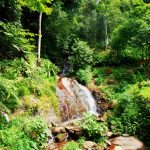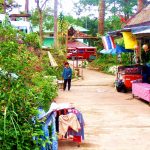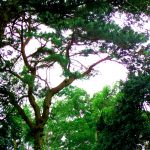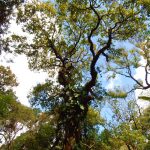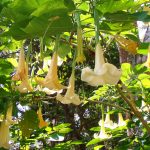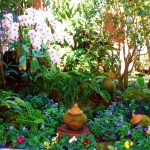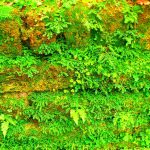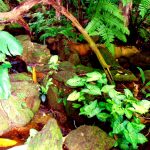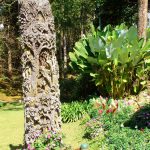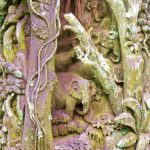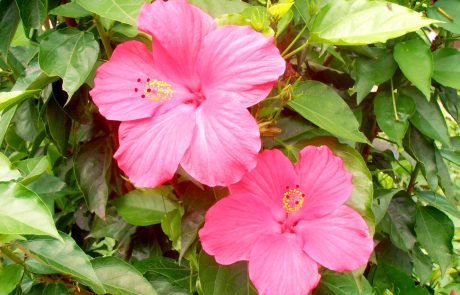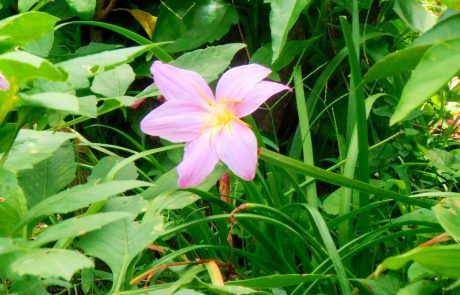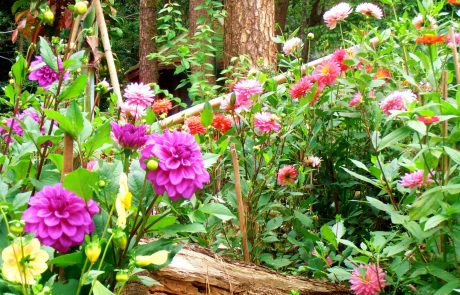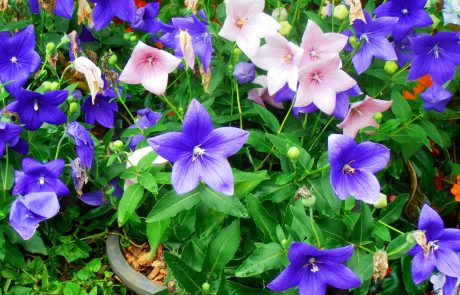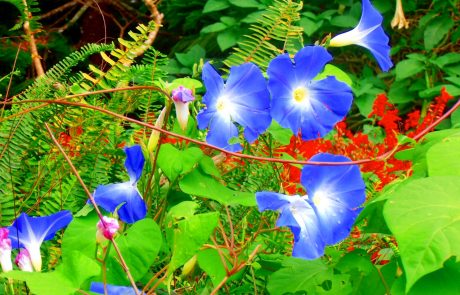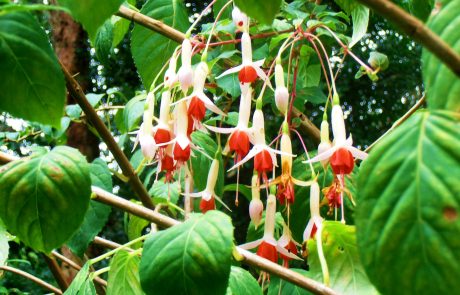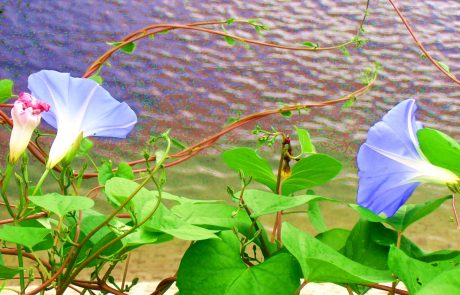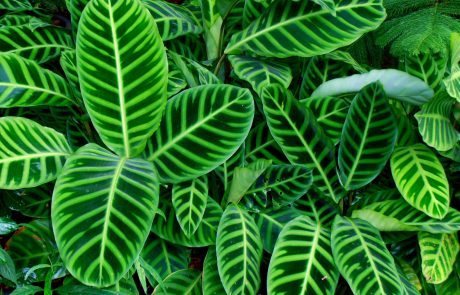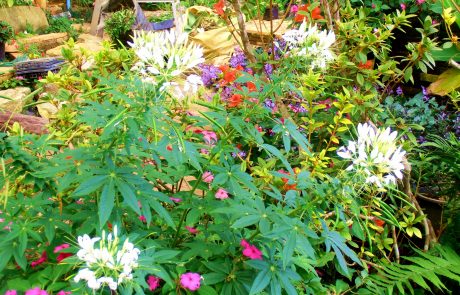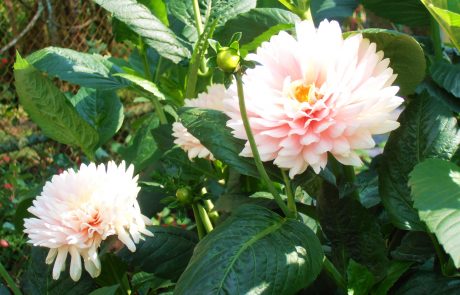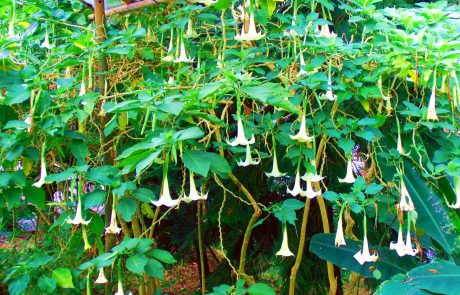
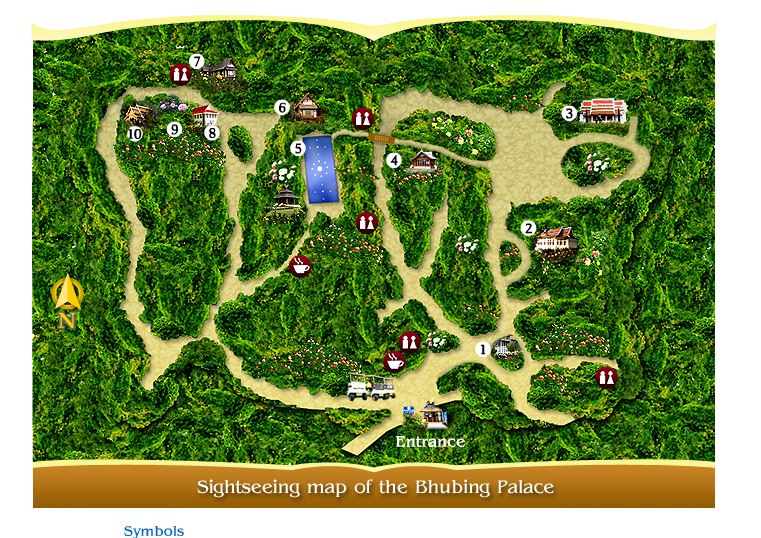
June 2018
In this post I want to celebrate the beauties of one of my favorite places in Chiang Mai, the Bhubing Palace Gardens that sit atop Doi Suthep mountain just to the west of the city. I’ve been there several times and now that my trips to Chiang Mai are fewer and farther between, I make a point of going up every time I visit. It’s possible to get there with public transportation, although there’s a bit of savvy necessary for success with that process, expertise about which I cannot claim with anything resembling truth in advertising. I rent a motorbike when I visit Chiang Mai and enjoy the trip up the mountain under my own power, at my own speed. There’s plenty to see on the way to the top, rest assured: Wat Palad, a gem of a temple complex which will figure in its own blog post soon, the incomparable Wat Doi Suthep, also worthy of its own post, and lovely views from the mountainside over the city and the Ping River Valley. I could wax poetic about the forest that embraces you as you climb the mountain toward the top where the gardens hold forth. The first time I went there I’d been over a year in Saudi Arabia and didn’t fully realize just how traumatic that adjustment was to a forest-dweller like myself. When I saw during my first trip up the mountain the undulating contours of the forest studded all about with flowering trees (OMG flowering trees growing in real soil, is that even possible??) I nearly lost my self-control. I was riding on the back of a friend’s motorbike and felt the impulse every few minutes to scream, “STOP!” just to take in the sight of the forest, which to my desert-blasted eyes was like sweet balm to something that had become very parched, indeed. On subsequent trips when under my own recognizance (and on my own bike) I have indeed dawdled mightily on the way to my destination. I have the forest pics to prove it, too, trust me on that one, Bridget. But our object of contemplation here is the palace gardens on their mountaintop perch, so let me not dawdle now in the recounting and get on with it.
Because of the distance from the city proper to the gardens and the intracacies of public transport thither, the gardens are not something on the lips of every tourist who visits Chiang Mai, especially if you’re a backpacker in one of the flop houses in the Old City looking for local color and cheap beer. The tourist literature on the gardens makes a point of reminding visitors that this is a royal residence, so due respect for sartorial standards is expected (see here). No floppy shorts, muscle shirts or flip flops, thank you very much. You have to dress like a lady even if you aren’t one 🙂 Since natural modesty is one of my defining traits (yes, Bridget, one was raised properly I’ll have you know), I just wore what I usually wear and passed through the entrance gate with flying colors. Organize yourselves so that the same happens to you. This is a public garden when the royal family is not there (which is nearly all the time), but it’s good to remember that Bhubing Palace is called a palace because it’s a working royal residence. Entrance into the palace buildings is not available. The grounds are made available to the public in the absence of royals, yes, but this isn’t a municipal garden, it’s a royal estate managed by the crown. So mind your p’s and q’s as you go about, kids, it’s not a place for uproarious behavior. I’ve never seen any watchmen about the place on my visits, but if you let your kids go for a swim in the pond with the fountain, I expect they’ll appear quickly out of the woodwork. A word to the wise is sufficient, right?
The map above gives the layout of the palace grounds and I follow the usual course to cover the entire area. It’s a large site, you can easily spend a whole day there if you like. In the middle bit near the pond with the fountain there’s a restaurant area offering a place to cool your heels for a while (in addition to offering a stunning — and I do mean stunning — display of orchids). I’ll take you along that usual course and discuss the various areas and the delights they offer. The delights are many, I will dawdle and linger and go on at length about certain features and plant friends, but hey, this is a blog post, you can use the scroll wheel, so I’ll just let it rip and not worry about whether or not your eyes roll back in your head 🙂 Let’s have some pics to get things rolling (click on the thumbnail to get the larger image):
The first pic is by way of evidence for what I said about the reasons to dawdle on the way up to the gardens. This waterfall lies just to the south of Wat Pra That Doi Suthep, the main temple complex on the mountain famous as a site of pilgrimage. The falls is just by the side of the road, it doesn’t even have its own turnout for viewing, you have to pull over to the side and hoof it over to the base to have a good look. It’s just one of the places I always stop during my trip up to the gardens, there are many more.
When you arrive at the palace you find in its vicinity what resembles a large public market, together with a conference facility used for events and displays about agricultural projects sponsored by the royal family. The market stalls have a wide variety of items for sale, including lovely clothing for men and women in traditional Thai style with fantastic embroidery, which tempt baht out of my pocket more easily than I like to admit. There are food stalls, as well, but I can’t report on them from experience since I didn’t go in for the food stalls on any of my visits. It’s not that I’m squeamish in that regard, I’ve been brave more than once in Chiang Mai at the markets downtown, but I usually load up on grub before I head out for the day and find a coffee and a pastry at the restaurant on the palace grounds enough to keep me moving for the duration of my perambulations. In the small public market at the base of Doi Suthep as you begin the ascent of the mountain you find offered those delicacies so beloved of people from Isaan — bugs. Quite an interesting variety of them, in fact. In this case, I’ll admit outright to being squeamish in the interests of truth in advertising. If you’re a braver man than I, then go for it, crunch crunch 🙁
At the evelation at which the palace sits, the forest composition is quite different from what you find at the base of the mountain, obviously. As anywhere in the semi-tropics and tropics, to find a change of biome you don’t go north, you go up. As in the Philippines where I currently live, going up usually means one thing: pines. You’d think in this day and age a Google search would yield with a few clicks the botanical name of the pine species that inhabits the upper reaches of Doi Suthep. Well, think again, babes. I could spend God knows how long trying to chase down the botanical name, of course, but as I write this I think to myself, pines is pines at the end of the day and nobody but me gives a rip anyway, so take the easy road, kiddo. And that’s exactly what I’ll do. So happy hunting if your peace of mind and well-being depends on knowing the Latin associated with our dear Doi Suthep pines, I’m going for the aesthetics here, not the science. They look Japanese, if you consider the matter carefully. I say that perhaps because pines figure prominently in Japanese art, of which I’m inordinately fond. The pines on Doi Suthep are of the same type, with spreading branches that make lovely, sinewy silhouettes against the sky. Not like the jack and Ponderosa pines I’m used to in the States, of course, which know only one direction — bolt upright — and spread their limbs at right angles to the trunk in a show that can be impressive when large in scale but fails to capture the imagination at close range. The Doi Suthep pines captivate no matter what your perspective in relation to them might be. Dawdle a bit among them, as I always do before heading into the palace grounds, they’re essential parts of any visit IMHO. Best not to miss them here, because down in the flatlands you’ll find not a one — they only live at the posh addresses up on the mountaintop.
The pines are, however, accompanied by a wonderful variety of other trees that do equally admirable aesthetic duty, as the last pic in the row adequately demonstrates, I hope. Once again, I stand before you bereft of scientific data. I’ve no idea at all what species is in the pic, and I’m not bovvered to find out. Let’s just enjoy the show, shall we?
So, into the palace grounds at long last. The best way to proceed is to lay out a set of images that follow the walkway from the entrance to the palace itself so I can comment as though we were walking along it. Here goes:
Yes, Bridget, right off the bat there are orchids. Very impressive orchids, too, into the bargain. For anyone who’s a frequent visitor to Chiang Mai the sight of orchids becomes commonplace, since they grow like weeds there and flourish without very much being done except putting them in a spot and letting Nature take its course. All the same, the eyes remain alert to their charms (mine do, in any case) and when they see a display like the one in the first pic the message they send to the feet is brief, sharp and crystal clear: STOP! The handsome chiaroscuro effect in the photo that places the white orchid in the sunlight was luck of the draw, however much I’d like to claim it as evidence of my prowess in photo composition. But this is just the beginning …
Yes, Bridget, roses. Just as in the hill stations of India, although here at Bhubing not tended by English spinsters recreating a bit of Sussex or Kent in the tropics, there are roses at the Palace Gardens. But to be frank, they’re not particularly impressive, if one tells oneself the bald truth of the situation. In the city nearest the town from which I hail in the Pacific Northwest is a public rose garden, twice the size of the one at Bhubing, which by comparison would show the blossoms at Bhubing in a decidedly unfavorable light. The ones near my hometown are fat, glossy, in good years they look like they’re on steroids and they come in a fantastic variety of form and color. The ones at Bhubing remind me of larger specimens of those overwrought double-flowered miniature roses one gets for one’s birthday. We are not impressed. I fully appreciate the uniqueness of the Bhubing Rose Garden from the standpoint of botanical rarity in the environment it inhabits, but if one faces facts then the show it offers is anemic and mildly depressing. Go ahead, flame me if you must. If you detect an underlying disinclination toward our rose friends, I’ll not contradict you. Rather more bother than the result justifies, in my unstudied opinion. But before the discussion gets heated and threatens to spin out of control, let’s move on, shall we? 🙂
The ornamental group in the next pic is along a walkway heading toward the Palace itself. I’ll take it over the Rose Garden any day of the week. It exudes that magical touch Thai people have for creating ornamental groups that strike the eye with their perfect combination of lively interest and complete repose. I have no idea how they do it. I’m sure if I tried to do something similar the results would be disastrous. It’s part of Thai culture, dare I say Thai civilization, and the sense such plantings convey to me is of deep-seated aesthetic traditions developed over centuries that manifest themselves effortlessly through people for whom the composition of such loveliness is second nature. I observe and allow myself to be instructed by that attribute. I feel the sense of that civilization seep into me as my gaze lingers on the plantings, which I appreciate as essentially Thai. What a wonderful cultural legacy to have in one’s native repertoire.
So, smarty pants, you tell me what the flower in the next pic is. Datura? Brugmansia? The botanical literature tells us that Datura has erect flowers while Brugmansia has pendulous flowers. But a look at the gardening literature will show Datura specimens with pendulous flowers, and botanically several species that were previously listed as Datura in the nomenclature have been moved to Brugmansia. I know a proper Brugmansia when I see one, because the plants are stropping and the flowers are enormous. But in the chimeric world of horticultural hybrids one can’t be so sure of the botanical ground under one’s feet. In the conservatory area where this plant lives there are several specimens absolutely loaded with blossoms. Heavenly, no matter what the species, and despite the fact that they’re in the nightshade family (Solanaceae), squarely at the deadly poisonous end of that group. So look but don’t touch, kids. We have a long walk ahead of us and we don’t want to be calling 911 now, do we.
The Palace itself is a handsome thing but nothing on the order of the extraordinary temples in Chiang Mai. It was built in 1961 in the space of five months and is hardly used. I find nothing architecturally arresting about it, but the roofs with their garudas (only allowed on temples and on royal buildings) cut a fine figure against the sky, hence the photo.
The next pic is of a garden area on the grounds of the Palace itself, and one suspects it may well have been composed by the same person who did the composition in the third pic of Row 1. A composition that is at once extremely interesting and restful to the eye. Again, the chiaroscuro effect on the white orchid is Mother Nature at work, I can’t take the credit. But I get an A for timing 🙂
The statue in the next pic is of a Kinnari (more information here), a mythical figure one happens across with some regularity in public spaces in Chiang Mai. Supposedly the Kinnari represents a pinnacle of feminine charm, despite the anatomical anomalies, which in the flesh would be a bit alarming even at the best of times. This most definitely falls for me under the category “No Frigging Clue.” Having a woman be half bird with a set of claws like you see in the photo hardly seems to me a model of feminine charm, even if you have a foot fetish a few notches beyond the usual range on the gauge. And just think when you’re paired up with a woman like that, whose claws could easily disembowel you with the strike force of an enraged ostrich, what might happen if you chance to say the wrong thing at the wrong time. “Did you just say this dress makes me look FAT???” Oh dear … one shudders to think. But I leave such matters to those in the know. Continuing our tradition of truth in advertising, I cannot claim expertise in such doings, so best that I keep it zipped and move along.
The last pic in the second row just goes to show that you don’t have to be an angiosperm to be a class act. The moss and ferns you see cover a fairly large section of brick wall near the Palace proper. I was struck, as so often I am in the tropics, at the wonderful patterns made by the textures and the foliage shapes of the ferns. Mother Nature has her own magic touch in the botanical domain, of which this is a fine example. One couldn’t hope to outdo it.
The gardens are built on the side of the mountain, so obviously a bit of climbing figures into the picture. We’ll do some now as we move from the area near the Palace to the upper gardens and the delights they hold in store. Here are some pics from the passage:
As you move from the vicinity of the Palace to the upper gardens you pass through a patch of native woodland. The first pic shows a plant that sits in many a living room in the area of the States I come from — but here at Bhubing it’s a forest plant living outside a pot, quite happy in the native landscape. Let’s hear it for the tropics, kids 🙂
The bench in the next pic has accommodated my backside on more than one occasion. It sits on the edge of a clearing with some work buildings along one side. I call the area the Green Room. Since a picture is worth a thousand words, I’ll leave it to the photo to do the talking. What a lovely place to sit and admire the forest.
After the ascent (not terribly taxing, mind you) through the woodland all of a sudden you come out into cultivated space again, rampant with flowers in mass plantings — zinnias, fuchsias as a hedge — yes, don’t think I’m making up stories, I have the pics to prove it — along with borders of massed Impatiens in all manner of colors. Stunning. After dawdling to admire these lovely things you reach the pond with its fountain. Ponds is ponds, so I’ve refrained from supplying an image — let it be a surprise for you during your visit, and may the weather be much less overcast for you if you are the shutterbug type. In that particular case I do NOT get an A for timing, since my photo op days have been consistently gloomy. Rats. But as a tourist you pays your money and you takes your chances.
The bridge panels in the next photo are also from the pond area and I was delighted by their fine detail and the juxtaposition with them of the blossoms growing beside. It seems in Chiang Mai that you can turn your head in any direction you please and come face to face with some loveliness someone has placed there to please the eye, not only to serve a purpose. Functional ornamentation, is there any better way to sweeten the course of daily life? I think not.
After passing the pond you come to the upper gardens and their denizens, which include buildings made for the Queen Mother, of which more presently. The large upper garden area as well as the one lower down by the palace give me the impression of influence from an English source. Not Capability Brown, to be sure, nothing on so grand a scale as that — something more on the order of Hidcote Manor or the gardens at Knole. I can’t honestly assess to what degree the landscape in the last pic is constructed and to what degree natural. Given that the gardens were established in 1961, one must assume the mature trees formed part of the original woodland, since it takes more than 50 years to grow trees that tall, even in Thailand. Since my involvement with garden history and design is decidedly Anglophile in nature, the associations I have must be said to be prejudiced toward that part of the world. If you’re from Tennessee and have never crossed the state line, the gardens may strike you as a dead wringer for something in Chattanooga, who knows … In any case, they are lovely, and you stroll through them on your way to things which leave no doubt in your mind that you are, in fact, in Thailand.

This architectural gem is the temple of the Queen Mother, whose palace lies also in the area of the upper gardens. Because it’s a temple it offers considerably more detail of ornament than any of the residential buildings. Built in the traditional Lanna style with two stacked roofs, being insufficiently grand to warrant the usual three, it is to my mind the most attractive building in the entire complex, in natural a setting which I can only describe as “heartlifting.” Is that a word? No matter, it should be if it isn’t, because that’s exactly what this place does for the spirits. The buildings associated with the Queen Mother are more modest in scale than the main palace buildings, wherein lies their architectural success and their special appeal, I find. Were I myself a Queen Mother, I could think of no more amenable place for the conduct of my quiet royal life than in such precincts as these. Every visit I make to the gardens holds in store this spot and this building as special treats. When I arrive there I know I’ll be a long time sitting before I move on to the area nearby with the restaurant.
Yes, Bridget, orchids. Again. Can’t get enough of them, and at the restaurant near the upper gardens there’s a show of them that will leave your socks knocked down around your ankles. We’re on a royal estate, true, but the restaurant area is nothing fancy, as you can see in the first pic by looking at the structure that frames the stunning blossoms. We’re talking a couple food stalls indistinguishable from the stalls outside the palace grounds, not a fancy cafe with aircon and mirrored tiles encrusting the walls. Well, with ornamentation like that provided by our orchid friends, who needs mirrored tiles? It’s beautifully shady there and a lovely cool place to have a pause while you take a coffee and some sustenance to see you on your way round the rest of the gardens. For someone like me, orchids in my own native habitat mean almost inevitably a Phalaenopsis species struggling for survival in someone’s living room. The sight of free-growing orchids of this size and magnificence is enough to raise the heart rate and increase the blood pressure. Fantastic, that’s the only word suitable.
Equally gobsmacking is the teak log sculpture in the lawn area beside the restaurant. The Thai genius for woodcarving is fully the equal of the Thai genius for horticultural design. We have in this sculpture evidence of that genius which admits of no contradiction. The detail pic last in the row shows the fine work involved at the micro-level, which is to my mind fully equal to the wonderment of the macro-level when viewing the entire piece from a distance. This ability to do fine woodcarving appears also to be genetic to the Thais. I’ve never seen such a wealth of it anywhere else.
When I was at the Queen Mother’s Temple one visit my thoughts drifted to the Magi Chapel in the Medici Palace in Florence with the frescoes by Benozzo Gozzoli. Seeing the teak log carving at the gardens brought to mind the west front sculptures of Wells Cathedral. Being the fusspot I am, I sat for a bit as I drank my coffee trying to think why those particular things came up in association, and what those associations actually mean since obviously there’s no direct relation that makes any sense at all. The crux of the matter with regard to the temple and the Medici chapel turns out to be individuality. The issue at stake in the matter of the teak log carving and Wells Cathedral is Nature and our relation to it. Surprise, surprise. I feel a discourse coming on, so use your scroll wheel if you need to 🙂
Both the Queen Mother’s Temple and the Magi Chapel are private devotional spaces. They make no public statement since public audience figures neither in the architectural design nor in the decorative scheme. But what a difference we find between the Thai and the European manifestations of such space. The Queen Mother’s Temple is architecturally indistinguishable from hundreds of other temple buildings in northern Thailand. There is nowhere blazoned across that architectural scheme the fact that the building is the private devotional space of the Queen Mother. Consider by contrast the Magi Chapel in the Medici palace. Along with the religious bits there’s a good deal of chest-thumping going on. The Medici figure prominently in the pictorial scheme, as of course they would, being Medici, and things are skewed pictorially in such a way that it appears the journey of the Magi couldn’t possibly have happened without the involvement of the Medici, which is of course complete piffle. I think Gozzoli’s frescoes are delightful, full thumbs up. But I’m also aware when viewing them that I’m being beaten over the head with the fact that they’re in the Medici palace and are really more about the Medici family than about the voyage of the Magi. You could move the Queen Mother’s Temple to any temple complex in northen Thailand you choose and it would fit seamlessly into its new home. It beats no chests. The individual for whom the building was created does not define the structure. In fact, that individual is nowhere to be found when experiencing the temple on its own terms. Therein lies the difference: the individual is part of an ancient tradition and is rightfully subsumed by a larger order of reality where individuality is not the defining element. Individuality is served by joining itself with something larger, something collective, something transpersonal. The Medici would never have dreamed of such a thing. That stance is alien to the secular domain of Western civilization, it’s for cloistered monks or nuns perhaps (those weirdos), but not for people in the real world. In Thai Buddhist civilization that stance is the order of the day for everyone, even for members of the royal family. No chest thumping necessary, thank you very much. Work out your own salvation with diligence.
I remember during my first months of living in Europe how scandalized I was by excursions to historical buildings in the area where I lived — Wolfenbuttel, in Niedersachsen. The Ducal Palace elicited special shock for me as I wandered through the rooms appalled at the crudeness of design and execution in the architectural detail. Cherubs with the faces of Miss Piggy, wings with three crude slits along the side to represent feathers … goodness sake, trained monkeys could do a better job of it. My luck at European cathdrals sometimes runs no better, especially where the sculpture is concerned. I mentioned in the post about Wat Ched Yod in Chiang Mai a sinking feeling from a visit to St. Michael’s in Hildesheim, which I visited and poked about for a good long while. The capitals are supposedly iconic as representatives of the Saxon Romanesque, but to me they looked like experiments from a session in which clay was handed over to an elementary school class with the instruction, “OK kids, let’s do our best to make angels and scary devils and all the other things you think of when you go to church.” Voila: St. Michael’s, Hildesheim. (Good thing I have my flameproof jacket on LOL) The west front sculptures of Wells Cathedral came to mind because they’re of the same ilk. Stand back a good distance and the ensemble gives a wow, no doubt about it. Get up close, however, and the impressions shift rather quickly. Some of the faces show character, yes, and the modeling of the drapery is competent, that’s true. But it’s all rather lackluster after a brief viewing and the eye becomes jaded with the sameness. A look at a closeup of the four female saints from the front of Salisbury Cathedral has a similar effect. The faces are of Generic Medieval Saintly Babe, and while the execution of the drapery is quite accomplished, the acanthus leaf capitals of the pillars that separate our four saintly lovelies show even more skill in design and execution, in my unqualified opinion.
Back to the teak log carving at Bhubing. Micro and macro levels are equally stunning. I believe the Thais took that lesson from Nature itself, which is stunning at both levels, as well. Sit in the forest and at the macro level you have a scene of great beauty. Zoom in to the forest floor, or the tree foliage or any other element of what you see around you and presto! also a scene of great beauty with details that will likely surprise you. No lines of plants cut from the same cloth like our Medieval Saintly Babes. The teak log carving at Bhubing performs the same feat at whatever level you choose to inspect it, macro or micro, it makes no difference. Just like Nature. So I think the Thais took instruction from the fantastic natural environment they inhabit and got their cue from what Mother Nature does on her own account. Quite simple, if one has the eyes to see it.
That simultaneous attention to detail and to the larger effect is characteristic of Thai aesthetics, I find. It’s not part of the Western tradition. We do big things well as a rule, but often our detail brings disappointment, unless you’re dealing with someone like a Bernini, where the detail is as ravishing as the whole. But Bernini is an anomaly, a solitary genius. What we see in Thai civilization is exquisite craftsmanship at multiple levels as part of an established and common tradition, not the anomalous product of individual genius. I’d prefer to be part of the Thai kind of civilizational pattern, given the choice. But I’m a Westerner, so I’ll just have to deal with it. 🙁
Since we’re wandering about a garden, it seem appropriate to close this post with a celebration of flowers from the gardens. Because of the altitude and the cooler climate, many of the species will be familiar to people in the USA and Europe. I present, then, for your delectation a gallery of beauties from the Bhubing. A picture may be worth a thousand words — words being the cheap trade they are — but they can do nothing to replace the experience of being physically present with these lovely plants and blossoms. For me that means: looking forward to the next visit 🙂

